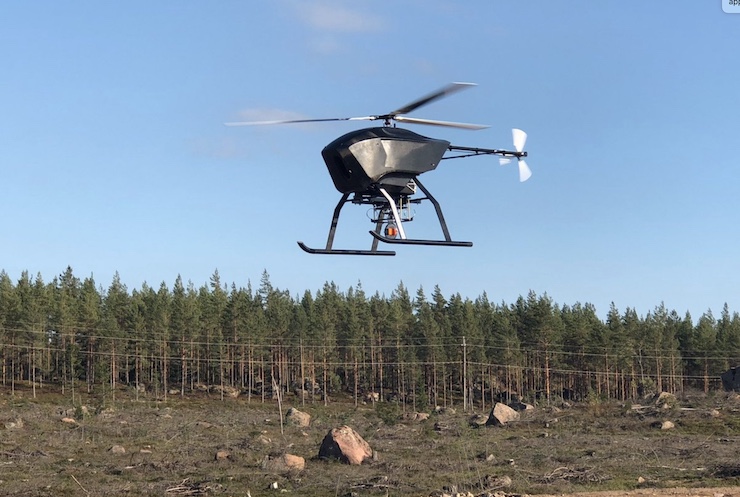
© Hepta Airborne
Estonians take great pride in their technological prowess. The country is the home of the creators of Skype, has one of the highest rates of internet connectivity, and has been utilizing online government voting systems since 2005. The country has a long standing history of implementing technology into everyday activities. Estonia became an early adapter of how drones could be used commercially to improve the lives of its citizens. In 2015, Henri Klemmer, Siim Maripuu, and Siim Heering came together to develop the first of their drone based companies, Flaperon OU.
Henri has a degree in Power Engineering from Tallinn University of Technology in Estonia. Both Siims have degrees in Aerospace Engineering from the Estonian Aviation Academy, while Siim Heering also has a master’s degree in Engineering and Mechatronics from Tallinn University. The three founded Flaperon to design drones that could be used to fit in the niche of the power grid industry. With the experience they garnered building a company from the ground up and working in the development of drone technology, the trio founded Hepta Airborne in the summer of 2017.
Headquartered in Tallinn, Hepta has built a custom drone and the accompanying software to inspect power lines. The drone Hepta designed is very different from others being used for power line inspections. Typically inspection drones are industrial sized quadrocopters like DJI’s Matrice 200 that have an average flight time of around 40 minutes. Hepta wanted a drone that could be airborne far longer than that and be operational in some of the extreme weather conditions typical of Northern European winters.
Henri, Siim, and Siim were inspired by previous consulting work they had done for helicopter companies that performed inspections on power lines. The drone they designed is about the same size as the DJI M200, but it is shaped like a helicopter with a large top rotor and a smaller rotor on the tail. Hepta’s drone is remotely operated, has an extra long flight time, and can be flown in rain, snow, and wind. As Henri explained, “These are long industrial range helicopter like drones that can stay in the air for approximately 3 hours and perform well under different weather conditions, enabling us to conduct missions for power lines where we have to cover hundreds of kilometers.”
After realizing the inadequacy of their manual inspection process, Estonia’s largest power provider, Elektrilevi, contacted Hepta to see if their drone model would benefit their customers. With more than 504,000 customers, Elektrilevi provides 93% of Estonia with power. Regularly inspecting over 60,000 kilometers of power lines and 24,000 substations is critical to maintaining continuous, safe power. As Hepta pointed out to Elektrilevi, not only are manual inspections inaccurate and dangerous, with many of the inspection sites in hard to reach places, a complete inspection cycle would take a single person 7 years to complete.
Hepta began a 6 month trial with Elektrilevi to improve their inspection rates. Elektrilevi was blown away by the results of the drone inspections within the first 2 months of the trial. A press release from Hepta stated that “Instead of typical 160 km per month, we reached to astonishing 320 km of analyzed grid, per one engineer.” With the help of a drone and a licensed pilot, Elektrilevi would be able to efficiently service all of their power lines and stations without increasing their budget or cutting jobs.
After the successful trial between Hepta and Elektrilevi, other power companies began to take notice. Recently, Hepta received a contract to begin inspecting power lines for the power provider of Finland’s lake district, Järvi-Suomen Energia (JSE). With over 100,000 customers dispersed amongst countless islands, capes, and lakes that see average wind speeds of 44mph, constant line inspections for JSE is critical. “It is essential for us to ensure the permanent availability of electricity for our customers. Reducing power outage time is one of the priorities,” said JSE’s Business Development Manager, Tomi Öster.
After a particularly bad storm in September of 2020, Hepta was invited to inspect the unique lake district lines that cover more than 27,000 kilometers for JSE. Over just 2 days, Hepta was able to identify several fallen trees that were contributing to power outages. Once these zones were rapidly identified, ground crews were able to make repairs in record time to restore power. To manually inspect Finland’s lake district would have meant that power restoration could have taken weeks to obtain. As Hepta pointed out, using the drones for inspection is “2-3x faster than on foot depending on the landscape. It takes an average of 15 minutes to inspect over 1 km of power lines on any landscape.”
Drones being used as inspection devices are quickly growing in popularity. They are making inspections quick and accurate while keeping inspectors safe. Hepta is continuing Estonia’s tradition of embracing technology by becoming leaders in drone inspections. Hepta is now serving power companies in 10 countries. Hepta recognizes that they are a young company, but they are passionate about bringing their clients success with the power of drones.
|